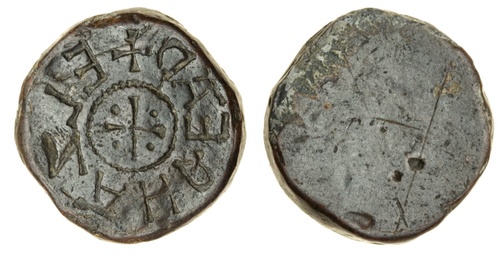
Auction: 18004 - Ancient, British and Foreign Coins and Commemorative Medals
Lot: 292
A Ninth century lead-alloy impression of a Penny, Athelstan I, East Anglia (c. 825-40), uniface, 13.62g (approximately 10 penny-weight), 21mm., 4mm.,
Reviewed by Marion Archibald (British Museum), for her corpus: "Aspects of Saxon and Norman London: (ii) Lead Objects with Official Coin Types", LAMAS, Special Paper 12, 1991, pp 279-346
Recorded by Michael Dolley (British Museum), 1963 - two casts subsequently made for the national collection.
Purchased privately c.1950 from the son of a gardener of the Bishop of Winchester
Marion Archibald theorised: "These [impressions] were made by using silver pennies in the role of positive dies to impress their designs and inscriptions onto a lead sheet or blank. This technique gives incuse and mirror image impressions on the lead. Both single-sided [this piece] and double-sided pieces exist. The former could be produced using only one coin, the latter required the lead blank to be placed between two coins. "This incuse technique seems, on present evidence, to have been employed only and exclusively in the early period (c. AD 720-840). This pattern is probably chronological, but it just might be geographical since all four early pieces are of East Anglian or Essex coin types."
She adds: "There is a strong correlation between the mint named on the fifty-eight provenanced lead pieces and the place where they were found... In the case of the Athelstan I of East Anglia, found at Winchester, the findspot is not certain, although it seems likely. A connection between the two places may not be so implausible as appears at first sight as there is a possibility, that the Athelstan of East Anglia, known to history only from his prolific coinage, may have been the documented West-Saxon prince of the same name who was sub-King of Kent under Aethelwulf (AD 825-39), who later became King of Greater Wessex (AD 839-58)". This piece has the same reading as the obverse of penny in Leiden, Netherlands, but although the die is very similar it is not identical. The reverse of the Leiden coin is by the moneyer Mon(ne); it has a plain cross within the inner circle and circumscription legend
Subject to 20% VAT on Buyer’s Premium. For more information please view Terms and Conditions for Buyers.
Sold for
£500




